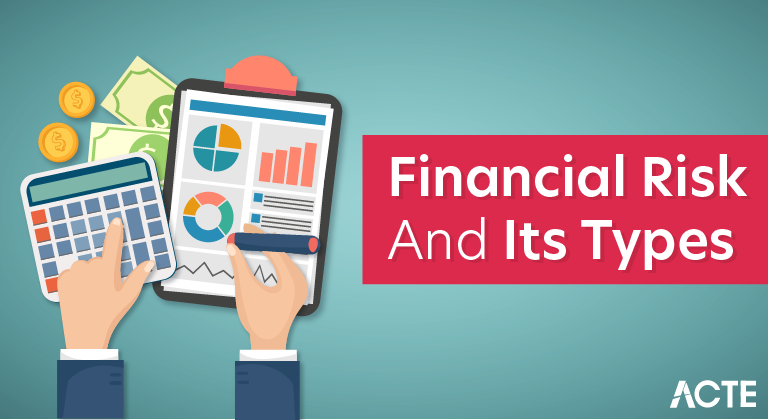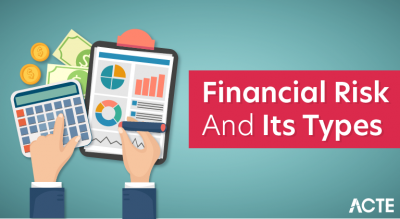
Financial risk is the possibility of losing money on an investment or business venture. Some more common and distinct financial risks include credit risk, liquidity risk, and operational risk.
The Basics of Financial Risk
Financial risk is a type of danger that can result in the loss of capital to interested parties.
- For governments, this can mean they are unable to control monetary policy and default on bonds or other debt issues.
- Corporations also face the possibility of default on debt they undertake but may also experience failure in an undertaking the causes a financial burden on the business.
- Individuals face financial risk when they make decisions that may jeopardize their income or ability to pay a debt they have assumed.
- Financial markets face financial risk due to various macroeconomic forces, changes to the market interest rate, and the possibility of default by sectors or large corporations.
Financial risks are everywhere and come in many different sizes, affecting everyone. You should be aware of all financial risks. Knowing the dangers and how to protect yourself will not eliminate the risk, but it will mitigate their harm
Thinking about financial risk tends to induce tunnel vision, especially in the wake of a market downturn or when you fear market uncertainty. However, risk, danger and opportunity are closely aligned aspects of uncertainty, and you need to consider each aspect as you make investment decisions:
- Danger is one-sided uncertainty. Danger produces only bad surprises, and its results aren’t measured in money or anything else that can be aggregated. Dangers should be minimised, subject to constraints.
- Risk is a two-sided uncertainty – both good and bad surprises are possible. Results of risk can be aggregated. Your goal is to optimise risk by choosing the right level for your circumstances. Don’t reflexively choose low risk for predictability or high risk for excitement.
- Opportunity is one-sided again, bringing only good surprises with unquantifiable results. Maximise your opportunities, subject to constraints.
- Market risk: Uncertainty due to changes in market prices.
- Credit risk: Uncertainty due to a failure of an external entity to keep a promise.
- Operational risk: Institutional uncertainties other than market or credit risk.
- Liquidity risk: Uncertainty about terms and the ability to make a transaction when necessary or desired.
- Funding risk: Uncertainty about whether investors will provide sufficient funds.
- Reputational risk: Uncertainty about how your entity will be perceived.
- Political risk: Uncertainty about government actions
Types of Financial Risks
The seven types of financial risk are –
- Asset-backed risk
- Credit risk
- Foreign Investment risk
- Currency risk
- Liquidity
- Stock Market risk
- Interest Rate risk
Asset-Backed Risk
Consumers borrow money for purchasing a car (auto loan), a house or running a balance on a credit card. These loans are treated as assets in the financial books of the financing entity. Bank, non-banking financial institution or a housing finance company are the financing entities.
The key value in this asset is captured by the steady stream of receivables that these assets are expected to receive. These are car loan EMIs, mortgage instalments, student loans EMI or credit card outstanding payments.
Financing institutions package these assets as asset-backed securities which are sold to institutional investors like pension funds and mutual funds.
Credit Risk
A credit risk happens when there is a chance that the loan borrower might skip, delay or default on his/her obligation to the bank or financial institution that has lent the money.
Let’s understand this with an example.
Say you were to borrow from a bank. And they offer you the loan at a much higher interest rate of say, 13%.
This 13% interest rate consists of three parts –
- Money that needs to be paid to the individual or institution from whom the bank borrowed the money,
- Account for the cost of acquiring and servicing the borrower and,
- Provision for potential delay or default in the repayment of the loan.
Management of the credit risk is the primary function of the financing institution. Underwriting the loan is a core responsibility of the lending institution. Offering a lower-than-required interest rate or offering the loan to a low-capacity-to-repay individual or firm can lead to tremendous losses and even bankruptcy.
Foreign Investment Risk
Foreign investment risk is the financial risk of swift and acute changes in the value of investments due to external factors like –
- Changes in accounting, reporting and auditing standards
- Nationalization. It refers to the transfer of private assets to the government often with no compensation e.g. Cuba expropriated all foreign-owned private companies after the Cuban Revolution in 1959 and Japan nationalized the Tokyo Electric Power Company after the Fukushima Daiichi nuclear disaster
- Changes in taxation rules. The Indian government raised a tax demand of ₹11,000 crores from Vodafone. This was related to Vodafone’s USD 11 billion acquisition of Hutchison Telecom in 2009. While the Supreme Court subsequently quashed the demand in 2012, the government amended its Income Tax Act retrospectively, putting the liability back on Vodafone Group. The issue is still under arbitration.
- Economic conflict. These can be trade wars like the one we see between the United States and China
- Political or diplomatic changes. Certain political parties in West Bengal have been resisting foreign investment in the state. This puts even existing investments at risk if they were to come in power.
- Regulatory issues
Currency Risk
Currency risk or foreign exchange risk can happen when a company is having a transaction with a foreign company where one currency is stronger than the other.
The two types of currency risks are –
- Transaction risk. These are losses that are likely to occur when dealing in different currency. Like the ones international food chains like Dominos and KFC face where they sell locally but report in US dollars.
- Economic risk. This refers to risk associated with different political policies, varied regulations and general state of the economy in the country where business is being conducted
Liquidity risk
Liquidity risks are financial risks that a given asset cannot be traded quickly enough to prevent a loss or expected profit.
There are two kinds of liquidity risks –
- Asset liquidity. This is where an asset cannot be sold in the market when you want to sell it. This is most common with houses where depressed conditions puts a stop on demand and pushes away buyers.
- Funding liquidity. This is where one does not have enough money to pay off a loan when it comes due. This may be because the borrower’s money is stuck somewhere else. A scenario where this occurs if when you, as a merchant, is expecting your goods to hit the port in Mumbai this Friday but due to adverse weather conditions, the goods will be delivered only the week next.
Stock Market Risk
Stock market risk is the chance that equities (stock prices) in general and the assumed volatility will change more than expected. These financial risks is not for any one particular company or industry but for the entire market as a whole.
Interest Rate Risk
Interest rate risk is the chance that an unexpected change in interest rates will affect the value of an investment.
Here’s how it works.
You purchase a bond of a housing finance company, say HDFC Limited. You bought one unit at a par-price of ₹1,000.
Because bond prices typically fall when interest rate rise, the downside interest rate risk is a drop in the value of the bond from ₹1,000 to ₹950. The reverse is true when the interest rate falls, you get a good appreciation in the value of the bond.
Tools to Control Financial Risk
Luckily there are many tools available to individuals, businesses, and governments that allow them to calculate the amount of financial risk they are taking on.
The most common methods that investment professionals use to analyze risks associated with long-term investments—or the stock market as a whole—include fundamental analysis, technical analysis, and quantitative analysis.
- Fundamental analysis is the process of measuring a security’s intrinsic value by evaluating all aspects of the underlying business including the firm’s assets and its earnings.
- Technical analysis is the process of evaluating securities through statistics and looks at historical returns, trade volume, share prices, and other performance data.
- Quantitative analysis is the evaluation of the historical performance of a company using specific financial ratio calculations.
For example, when evaluating businesses, the debt-to-capital ratio measures the proportion of debt used given the total capital structure of the company. A high proportion of debt indicates a risky investment. Another ratio, the capital expenditure ratio, divides cash flow from operations by capital expenditures to see how much money a company will have left to keep the business running after it services its debt.
In terms of action, professional money managers, traders, individual investors, and corporate investment officers use hedging techniques to reduce their exposure to various risks. Hedging against investment risk means strategically using instruments—such as options contracts—to offset the chance of any adverse price movements. In other words, you hedge one investment by making another.
Pros and Cons of Financial Risk
Financial risk, in itself, is not inherently good or bad but only exists to different degrees. Of course, “risk” by its very nature has a negative connotation, and financial risk is no exception. A risk can spread from one business to affect an entire sector, market, or even the world. Risk can stem from uncontrollable outside sources or forces, and it is often difficult to overcome.
While it isn’t exactly a positive attribute, understanding the possibility of financial risk can lead to better, more informed business or investment decisions. Assessing the degree of financial risk associated with a security or asset helps determine or set that investment’s value. Risk is the flip side of the reward. One could argue that no progress or growth can occur, be it in a business or a portfolio, without the assumption of some risk. Finally, while financial risk usually cannot be controlled, exposure to it can be limited or managed.
Pros
- Encourages more informed decisions
- Helps assess value (risk-reward ratio)
- Can be identified using analysis tools
Cons
- Can arise from uncontrollable or unpredictable outside forces
- Risks can be difficult to overcome
- Ability to spread and affect entire sectors or markets





